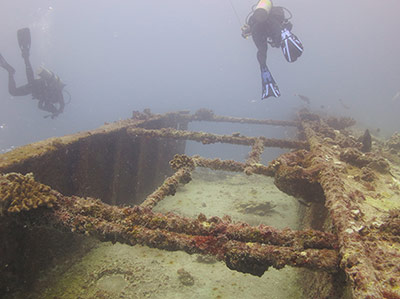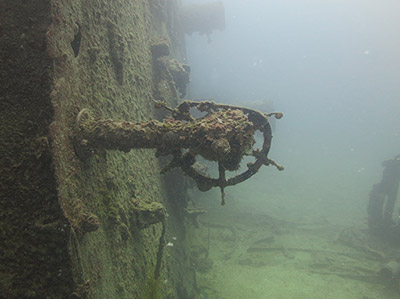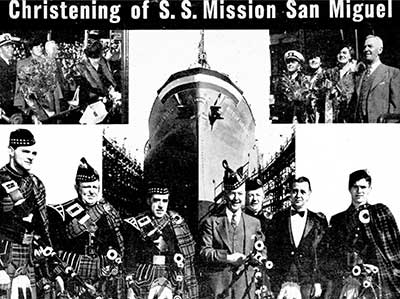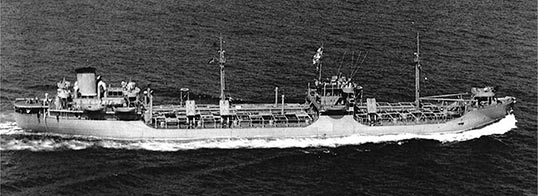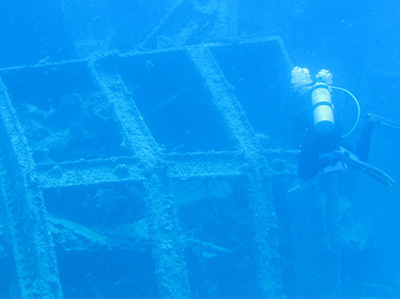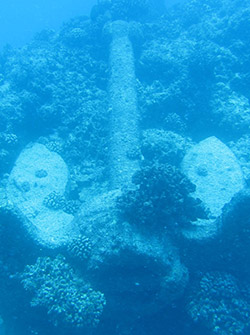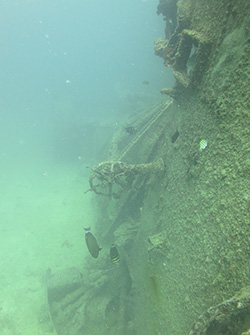An Enormous Discovery:
USNS Mission San Miguel Emerges out of the Maze at Maro Reef
Finding a shipwreck site in Papahānaumokuākea Marine National Monument is always an exciting event. However, finding a 523 foot World War II era tanker lost on the reef for over 50 years is a discovery like no other. A team of NOAA maritime archaeologists made such a discovery on August 3, 2015: the wreck of USNS Mission San Miguel, lost on October 8, 1957 at Maro Reef. The team was conducting a maritime heritage survey on an annual multidisciplinary research expedition to Papahānaumokuākea Marine National Monument aboard NOAA ship Hiʻialakai. Following thoughtful study of the historic records of the loss event, along with analysis of the course the ship was running prior to running aground on the reef, the team headed in to the field at Maro Reef in hopes of relocating this enormous shipwreck site that had been eluding maritime archaeologists for several years. Maro Reef is an intricate maze of reef with visibility that is often murky. With barely any emergent land, it can often be a spooky place to work. Exactly the type of spot you’d imagine a shipwreck site would be hidden on the seafloor.
On August 3, 2015, a four person maritime archaeology team began searching for the shipwreck site using towboard and drift dive surveys in the area where the Mission San Miguel was reported lost. After thoughtfully planned search and survey, the team identified one substantial and largely intact portion of the vessel, as well as numerous concentrations of disarticulated wreckage scattered over a relatively discreet area. At 523 feet, this is the largest ship reported lost in PMNM, and an interesting glimpse at one of the World War II era workhorse vessels of the United States Navy with a history that reflects the frantic pace of wartime shipbuilding efforts and role that petroleum played in military strategy.
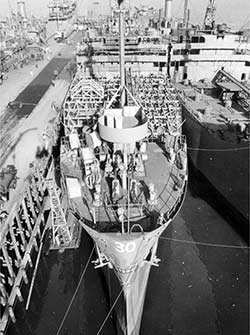
SS Mission San Miguel fitting out, 26 November 1943, 27 days after launching. Credit: www.navsource.org/Auke Visser
The T2 tanker Mission San Miguel was laid down on August 11, 1943 under a Maritime Commission contract by Marine Ship Corporation in Sausalito, CA. Hundreds of T2 type tankers were built for the Maritime Commission during World War II and used as Fleet Oilers. USNS Mission San Miguel was among the T2 SE-A2 Buenaventura class of tankers, which were constructed on the west coast of the United States (U.S.) and named for 18th century California missions. Despite their significant role during World War II in providing a mechanism for delivering much needed petroleum all over the world, there are no T2 type tankers preserved as museum ships or on display. This discovery provides us an exciting glimpse at this period in maritime transport history.
The ship spent the remainder of the war carrying fuel to U.S. forces overseas. It was acquired by the Navy on November 4, 1947 and chartered to American Pacific Steamship Co. for operations on the same date, and placed under the operational control of the Naval Transportation Service as Mission San Miguel (AO-129). On October 1, 1949 the ship was transferred to the operational control of the newly created Military Sea Transportation Service (MSTS) and redesignated USNS Mission San Miguel (T-AO-129). The ship served with MSTS until March 22, 1950 when it was taken out of service and laid up in the U.S. Navy Pacific Reserve Fleet at San Diego, California.
The tanker’s stay in the reserve was short, and on July 24, 1950 it was placed in service by MSTS to aid in supporting the U.S. troops stationed in Korea. For its military service, the ship was awarded a number of commendations including a National Defense Service Medal, a Korea Service Medal, a Republic of South Korea Service Medal (retroactive), and a United Nations Service Medal. The tanker continued to serve with MSTS until May 28, 1954, when it was placed in the San Diego group, Pacific Reserve fleet for laying up.
On November 1, 1956, USNS Mission San Miguel was reactivated and placed in service with MSTS. On October 1, 1957, it departed Apra Harbor, Guam (Mariana Islands) bound for Seattle, Washington. Manned with 42 persons including the Master, the tanker sailed in ballast with a draft of 12 feet forward and 24 feet aft. The planned track of the vessel was to pass through the Hawaiian Archipelago about 23 miles south of Maro Reef. LORAN reception in this area was poor, and bad weather prevented a celestial fix for several days; the Master and Chief Mate miscalculated their location to be much closer to Laysan Island. On October 8, 1957 at about 8 p.m., the tanker ran aground on Maro Reef while running at full speed and carrying only ballast.
Pearl Harbor’s Air-Sea Rescue Center issued “launch aircraft” orders at 10:40 p.m., and PBY patrols located the vessel at Maro Reef the next day. In the early morning hours of October 10, the Master ordered the ship abandoned and USNS T-LST 664 was at the scene to evacuate USNS Mission San Miguel personnel. All hands survived the wrecking event and were transported back to Honolulu. Following a United States Coast Guard (USCG) Marine Board of Investigation into the loss of USNS Mission San Miguel, it was recommended that the Master, Chief Mate, and Second Mate be charged with negligence. Additionally, it was recommended that the Chief Engineer was reprimanded for his inattention to duty. Rather than machinery or equipment causing the wrecking event, this was a case where human error and negligence resulted in disaster.
The U.S. Navy responded quickly to the grounding and a salvage task unit consisting of USN ships Safeguard (ARS-25), Reclaimer (ARS-42) and Lipan (ATF-85) was mobilized. Conditions prevented successful salvage operations and the ship was abandoned by the salvage team on October 24, deemed not to be a hazard to navigation. Mission San Miguel remained in records and charts until August 3, 2015, when the NOAA maritime heritage team discovered and positively identified the site at Maro Reef.
View a 3D image of the USNS Mission San Miguel at Maro Reef. In August of 2015, scientists visited the site of the Mission San Miguel at Maro Reef to collect photos for a 3D model of a portion of the enormous shipwreck site. This 3D image allows you to see the propeller and windlass, a few of the many artifacts scattered on the seafloor. Credit: John Burns
View a 3D Video of the USNS Mission San Miguel at Maro Reef. This link allows you to dive through the site and stop the video to take a closer look at interesting artifacts at the shipwreck site. Credit: John Burns
References:
Naval History and Heritage Command, Dictionary of American Naval Fighting Ships, Mission San Miguel (http://web.archive.org/web/20121024203628/http:/www.history.navy.mil/danfs/m12/mission_san_miguel.htm. Accessed on August 4, 2015.).
NavSource Online: Service Ship Photo Archive. USNS Mission San Miguel (T-AO-129) ex MissionSan Miguel (AO-129) (http://www.navsource.org/archives/09/19/19129.htm).
USMM.org, "Tankers Built in U.S. During World War II." (http://www.usmm.org/tankers.html).
United States Coast Guard, 1958. Commandant’s Action. Marine Board of Investigation, Mission San Miguel.
USNS Mission San Miguel (T-AO-129) (http://self.gutenberg.org/articles/USNS_Mission_San_Miguel_(T-AO-129))).
Visser, Auke. Auke Visser's Famous T - Tankers Pages (http://www.aukevisser.nl/t2tanker/id931.htm).
Whittaker, A. Davis, Jr. The T2 Tanker Page (http://www.t2tanker.org/).
